Topics:
1. Python Objects
2. Creating Python Objects with Classes
3. Class Object Attribute
4. Class Object Attribute - Oldest Cats Example
5. Encapsulation
6. Abstraction
7. Inheritance
8. Single Inheritance
9. Multiple Inheritance
10. Multi-level Inheritance
11. Hierarchical inheritance
12. Hybrid Inheritance
13. Isinstance Method
14. Polymorphism
15. Polymorphism - Cat Example
16. Use Parent Constructor Init function
17. Use Parent Constructor Init with super()
18. Use dir() to view Attributes and Methods of Object
19. Dunder Methods
20. Dunder Methods - SuperList Example
21. IsSubclass Method
22. MRO - Method Resolution Order
23. OOP Example I
1. Python Objects
>>Return to Menu
#OOP
class BigObject:
pass
obj1 = BigObject()
obj2 = BigObject()
obj3 = BigObject()
#OOP
print(type(None))
print(type(True))
print(type(5))
print(type(5.5))
print(type('hi'))
print(type([]))
print(type(()))
print(type({}))
print(type(obj1))
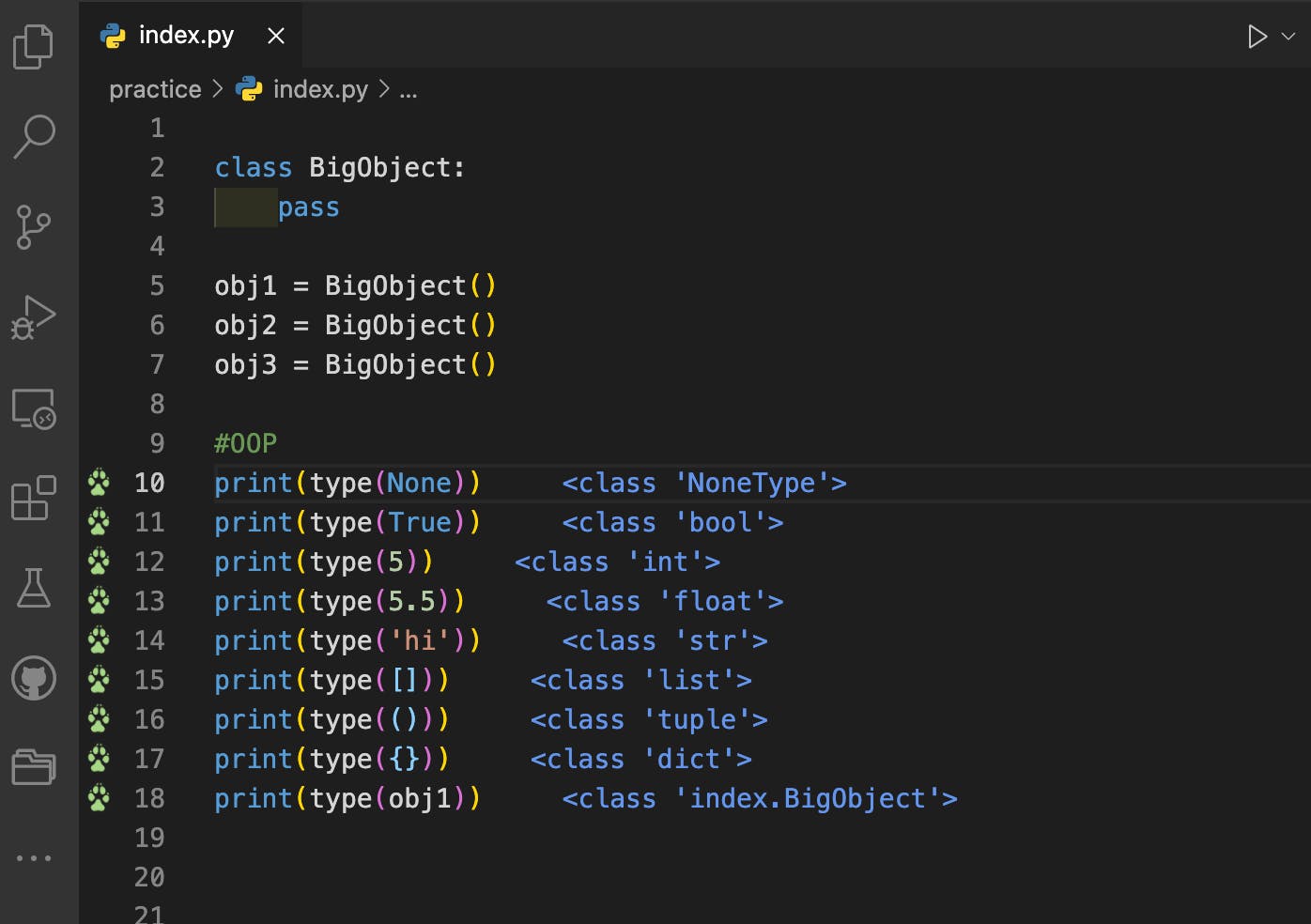
2. Creating Python Objects with Classes
>>Return to Menu
class PlayerCharacter:
def __init__(self,name,age):
self.name = name
self.age = age
def run(self):
return 'This is a "run" method.'
player1 = PlayerCharacter('Bob',23)
player2 = PlayerCharacter('Mary',30)
print(player1.name)
print(player2.age)
player2.weight = "80kg"
print(player2.weight)
print(player1.run())
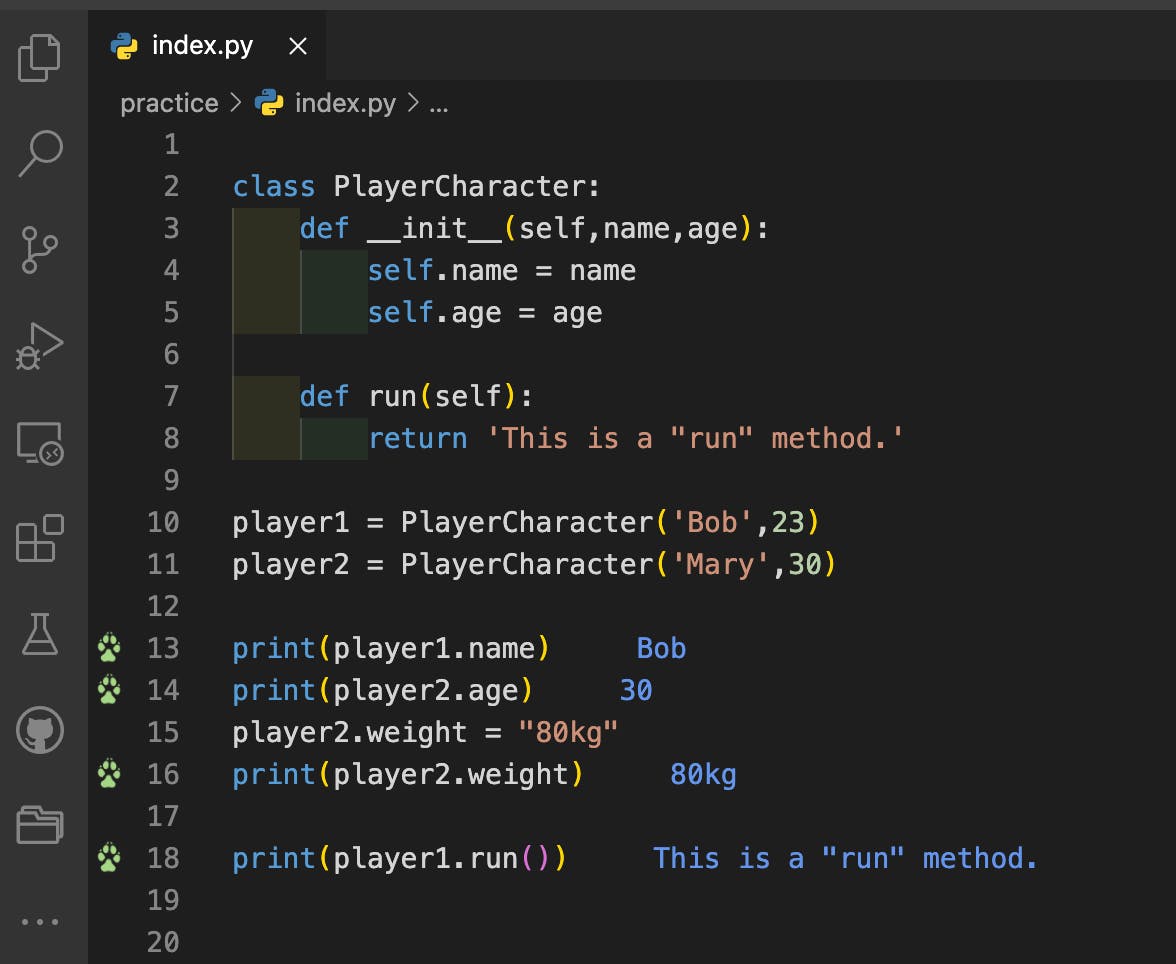
3. Class Object Attribute
>>Return to Menu
class PlayerCharacter:
position = "defender"
def __init__(self,name="Sally",age=50):
if self.position == "striker":
self.name = name
self.age = age
else:
self.name = f"Your name is {name}"
self.age = f"Your age is {age}"
def greet(self):
return f'Hello, {self.name}!'
player1 = PlayerCharacter('Bob',23)
player2 = PlayerCharacter('Mary',30)
player3 = PlayerCharacter()
print(player1.name)
print(player2.age)
print(player3.name,player3.age)
print(player1.greet())
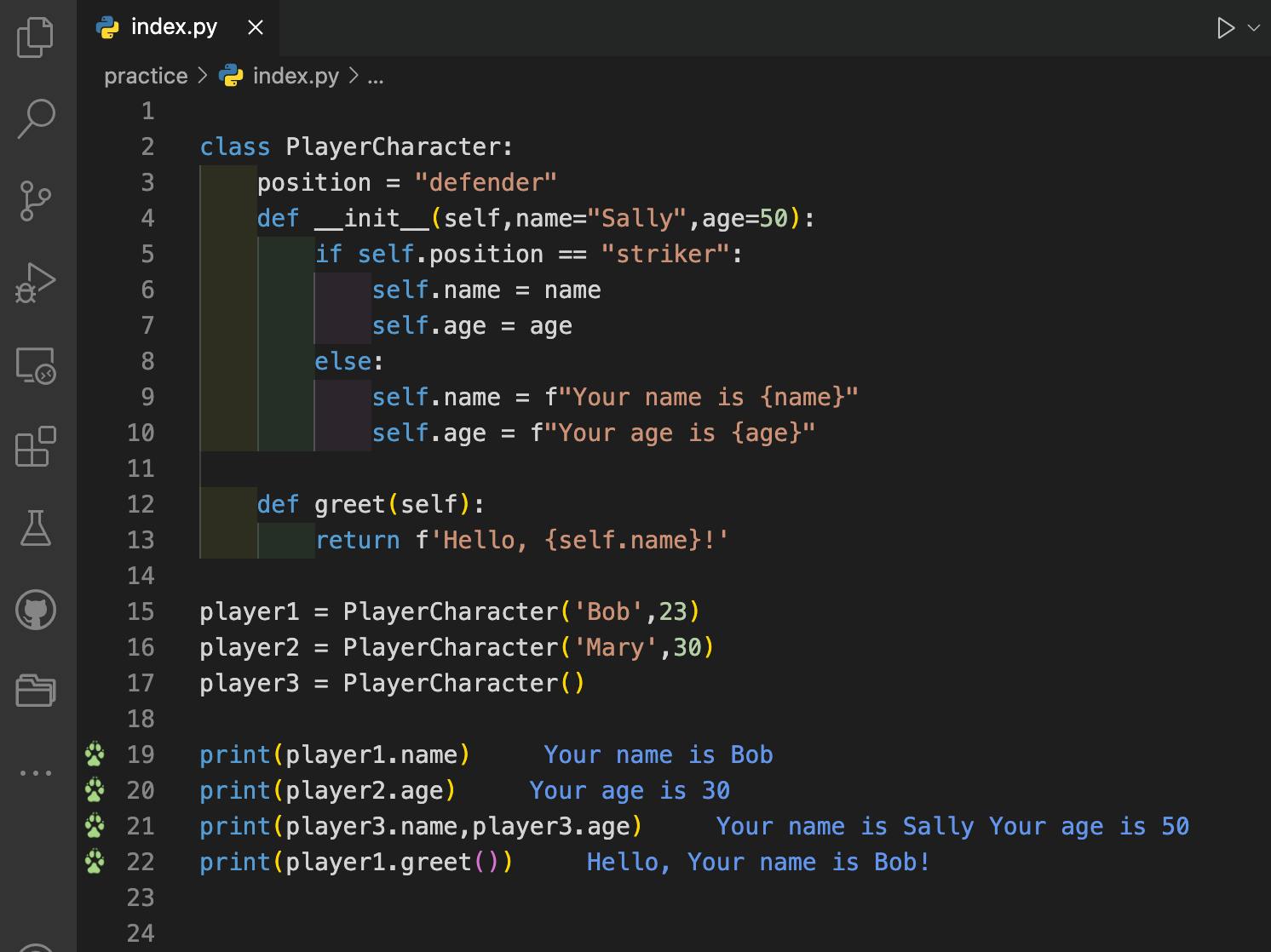
4. Class Object Attribute - Oldest Cats Example
>>Return to Menu
#Given the below class:
class Cat:
species = 'mammal'
def __init__(self, name, age):
self.name = name
self.age = age
# 1 Instantiate the Cat object with 3 cats
cat1 = Cat('Rubby',12)
cat2 = Cat('Carl',3)
cat3 = Cat('Jody',4)
# 2 Create a function that finds the oldest cat
def get_oldest_cat(*args):
return max(args)
# 3 Print out: "The oldest cat is x years old.". x will be the oldest cat age by using the function in #2
print(f"The oldest cat is {get_oldest_cat(cat1.age, cat2.age, cat3.age)} years old.")
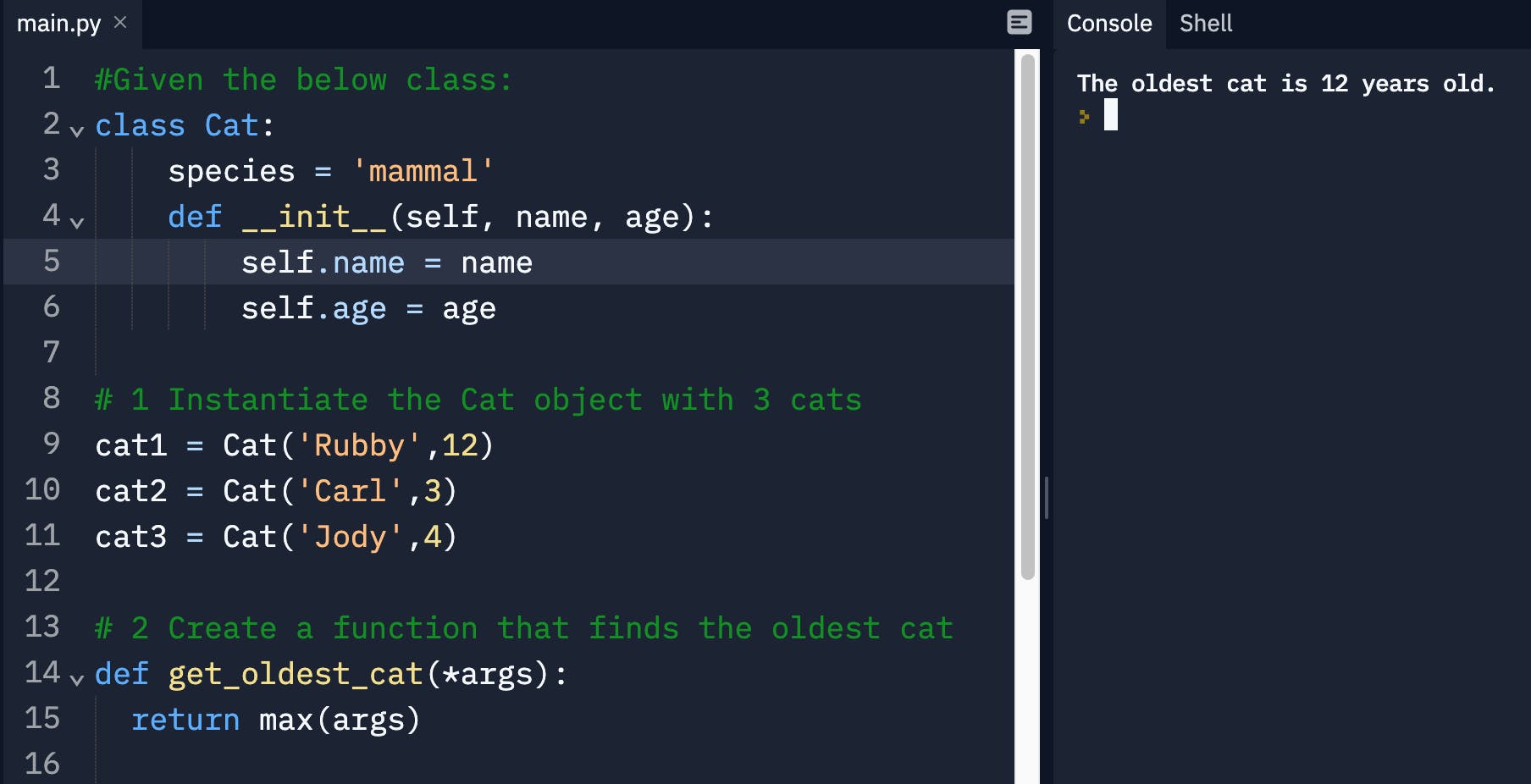
5. Encapsulation
>>Return to Menu
class PersonCharacter:
def __init__(self, name, age):
self._name = name
self._age = age
def speak(self):
return (f'My name is {self._name}, and I am {self._age} years old.')
person = PersonCharacter('James',34)
print(person.speak())
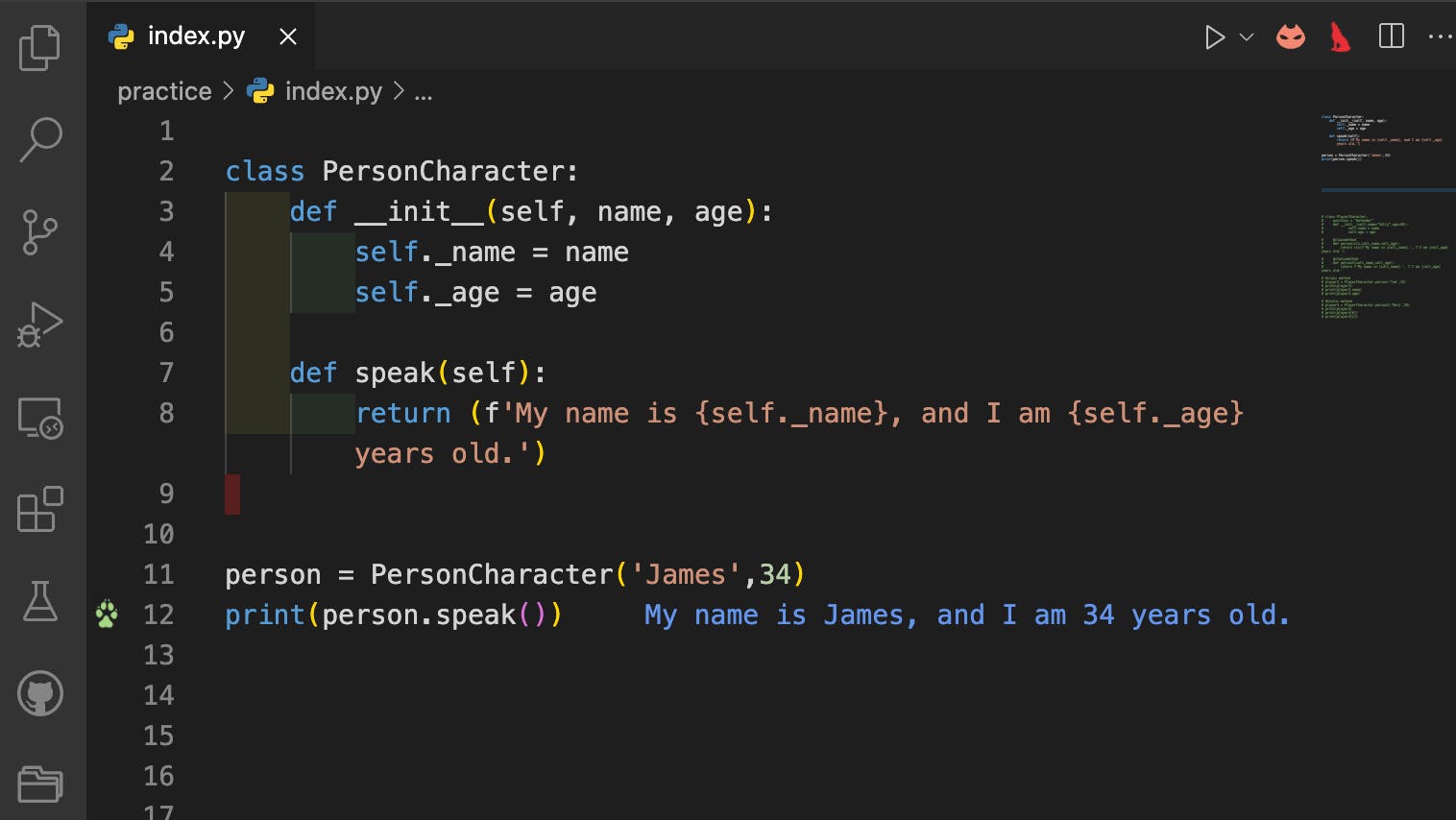
6. Abstraction
>>Return to Menu
An abstract class can be considered as a blueprint for other classes. It allows you to create a set of methods that must be created within any child classes built from the abstract class. A class which contains one or more abstract methods is called an abstract class.
When we want to provide a common interface for different implementations of a component, we use an abstract class.
A method becomes abstract when decorated with the keyword @abstractmethod.
# Python program showing
# abstract base class work
from abc import ABC, abstractmethod
class Polygon(ABC):
@abstractmethod
def sides(self):
pass
class Triangle(Polygon):
def sides(self):
print("I have 3 sides")
class Pentagon(Polygon):
def sides(self):
print("I have 5 sides")
class Hexagon(Polygon):
def noofsides(self):
print("I have 6 sides")
class Quadrilateral(Polygon):
# overriding abstract method
def noofsides(self):
print("I have 4 sides")
R = Triangle()
R.noofsides()
K = Quadrilateral()
K.noofsides()
R = Pentagon()
R.noofsides()
K = Hexagon()
K.noofsides()
7. Inheritance
>>Return to Menu
Different Forms of Inheritance in Object Oriented Programming
- Single Inheritance
- Multiple Inheritance
- Multi-level Inheritance
- Hierarchical Inheritance
- Hybrid Inheritance
class Student():
def __init__(self,name,age,sex):
self.name = name
self.age = age
self.sex = sex
class Course(Student):
def details(self):
return (f'Name: {self.name}, Age: {self.age}, Sex: {self.sex}')
student1 = Course('Adams',42,'Male')
print(student1.details())
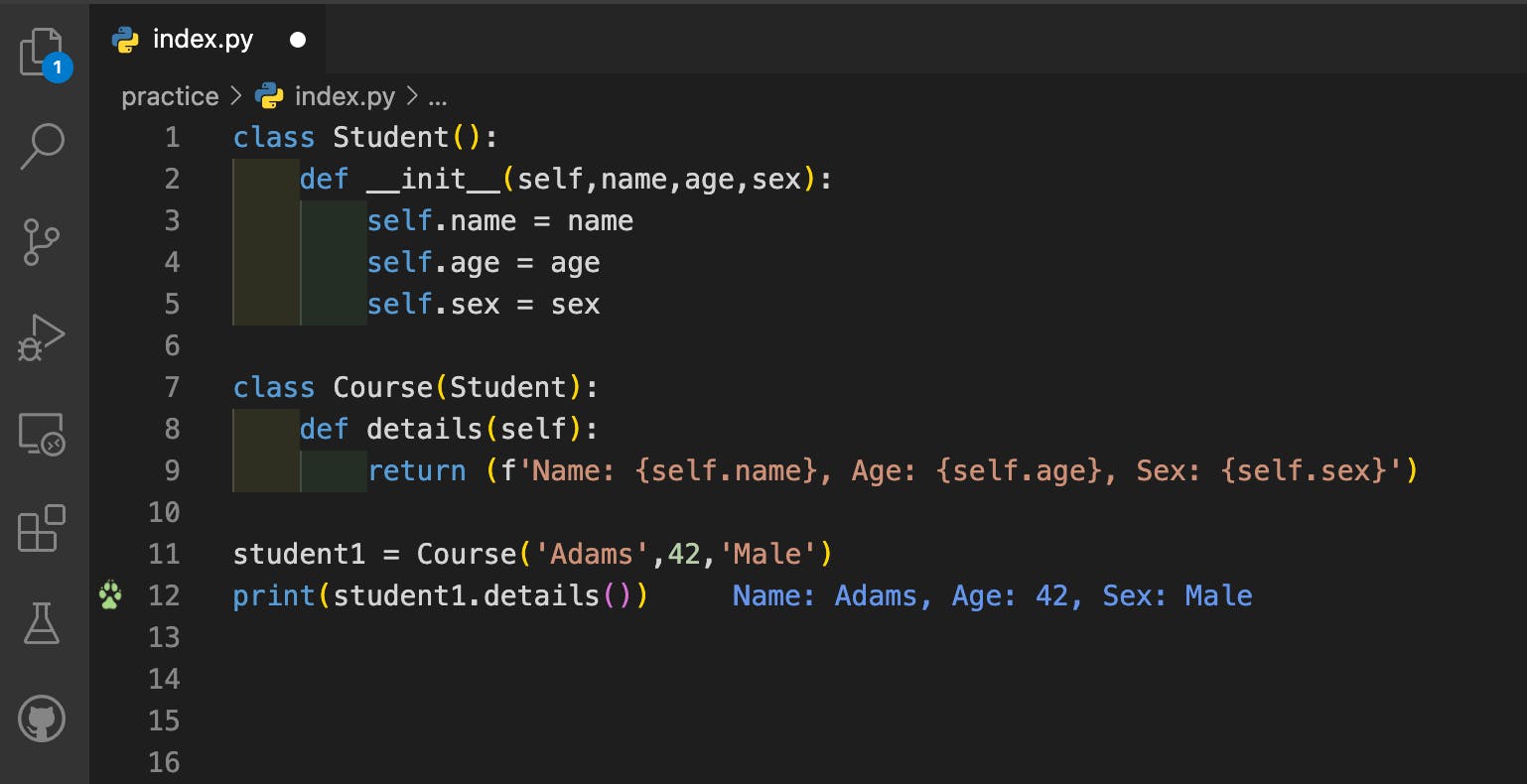
Another Example:
class User():
def start(self, name, age):
print('logged in')
return {'name' : name, 'age': age}
class Level(User):
def __init__(self, lvl, power):
self.lvl = lvl
self.power = power
def welcome(self, time):
self.time = time
return f'Welcome to {self.lvl}. Its {time}.'
level1 = Level('level 1', '50hz')
print(level1.lvl)
print(level1.power)
print(level1.start('John', 34))
print(level1.welcome('morning'))

8. Single Inheritance
>>Return to Menu
class Parent:
def f1(self):
print("Function of parent class.")
class Child(Parent):
def f2(self):
print("Function of child class.")
object1 = Child()
object1.f1()
object1.f2()
9. Multiple Inheritance
>>Return to Menu
class Parent_1:
def f1(self):
print("Function of parent_1 class.")
class Parent_2:
def f2(self):
print("Function of parent_2 class.")
class Parent_3:
def f3(self):
print("function of parent_3 class.")
class Child(Parent_1, Parent_2, Parent_3):
def f4(self):
print("Function of child class.")
object_1 = Child()
object_1.f1()
object_1.f2()
object_1.f3()
object_1.f4()
10. Multi-level Inheritance
>>Return to Menu
class Parent:
def f1(self):
print("Function of parent class.")
class Child_1(Parent):
def f2(self):
print("Function of child_1 class.")
class Child_2(Child_1):
def f3(self):
print("Function of child_2 class.")
obj_1 = Child_1()
obj_2 = Child_2()
obj_1.f1()
obj_1.f2()
print("\n")
obj_2.f1()
obj_2.f2()
obj_2.f3()
11. Hierarchical inheritance
>>Return to Menu
class Parent:
deff1(self):
print("Function of parent class.")
class Child_1(Parent):
deff2(self):
print("Function of child_1 class.")
class Child_2(Parent):
deff3(self):
print("Function of child_2 class.")
obj_1 = Child_1()
obj_2 = Child_2()
obj_1.f1()
obj_1.f2()
print('\n')
obj_2.f1()
obj_2.f3()
12. Hybrid Inheritance
>>Return to Menu
class Parent:
def f1(self):
print("Function of parent class.")
class Child_1(Parent):
def f2(self):
print("Function of child_1 class.")
class Child_2(Parent):
def f3(self):
print("Function of child_2 class.")
class Child_3(Child_1, Child_2):
def f4(self):
print("Function of child_3 class.")
obj = Child_3()
obj.f1()
obj.f2()
obj.f3()
obj.f4()
13. Isinstance Method
>>Return to Menu
class User():
def start(self, name, age):
print('logged in')
return {'name' : name, 'age': age}
class Level(User):
def __init__(self, lvl, power):
self.lvl = lvl
self.power = power
def welcome(self, time):
self.time = time
return f'Welcome to {self.lvl}. Its {time}.'
class Action():
pass
level1 = Level('level 1', '50hz')
print(level1.start('John', 34))
print(level1.lvl)
print(level1.power)
print(level1.welcome('morning'))
print(isinstance(level1, object))
print(isinstance(level1, User))
print(isinstance(level1, Level))
print(isinstance(level1, Action))

14. Polymorphism
>>Return to Menu
class Student():
def __init__(self,name,age,sex):
self.name = name
self.age = age
self.sex = sex
def details(self):
return {'name': self.name, 'age': self.age, 'sex': self.sex}
class Course(Student):
def __init__(self,course,score,pass_or_fail):
self.course = course
self.score = score
self.pass_or_fail = pass_or_fail
def details(self):
return (f'Course: {self.course}, Score: {self.score}, Result: {self.pass_or_fail}')
class Hostel(Student):
pass
student1 = Course('Maths',82,'Pass')
print(student1.details())
student2 = Student('Henry',34,'Male')
print(student2.details())

15. Polymorphism - Cat Example
>>Return to Menu
class Pets():
animals = []
def __init__(self, animals):
self.animals = animals
def walk(self):
for animal in self.animals:
print(animal.walk())
class Cat():
is_lazy = True
def __init__(self, name, age):
self.name = name
self.age = age
def walk(self):
return f'{self.name} is just walking around'
class Simon(Cat):
def sing(self, sounds):
return f'{sounds}'
class Sally(Cat):
def sing(self, sounds):
return f'{sounds}'
#1 Add another Cat
class Molly(Cat):
def sing(self, sounds):
return f'{sounds}'
#2 Create a list of all of the pets (create 3 cat instances from the above)
my_cats = [(cat_simon := Simon('Simon', 6)), (cat_sally := Sally('Sally', 3)), (cat_molly := Molly('Molly', 12))]
#3 Instantiate the Pet class with all your cats use variable my_pets
my_pets = Pets(my_cats)
#4 Output all of the cats walking using the my_pets instance
my_pets.walk()
#5 (Optionally) make the cats sing your tune... 😸
print(cat_simon.sing('lala'))
print(cat_molly.sing('meow'))
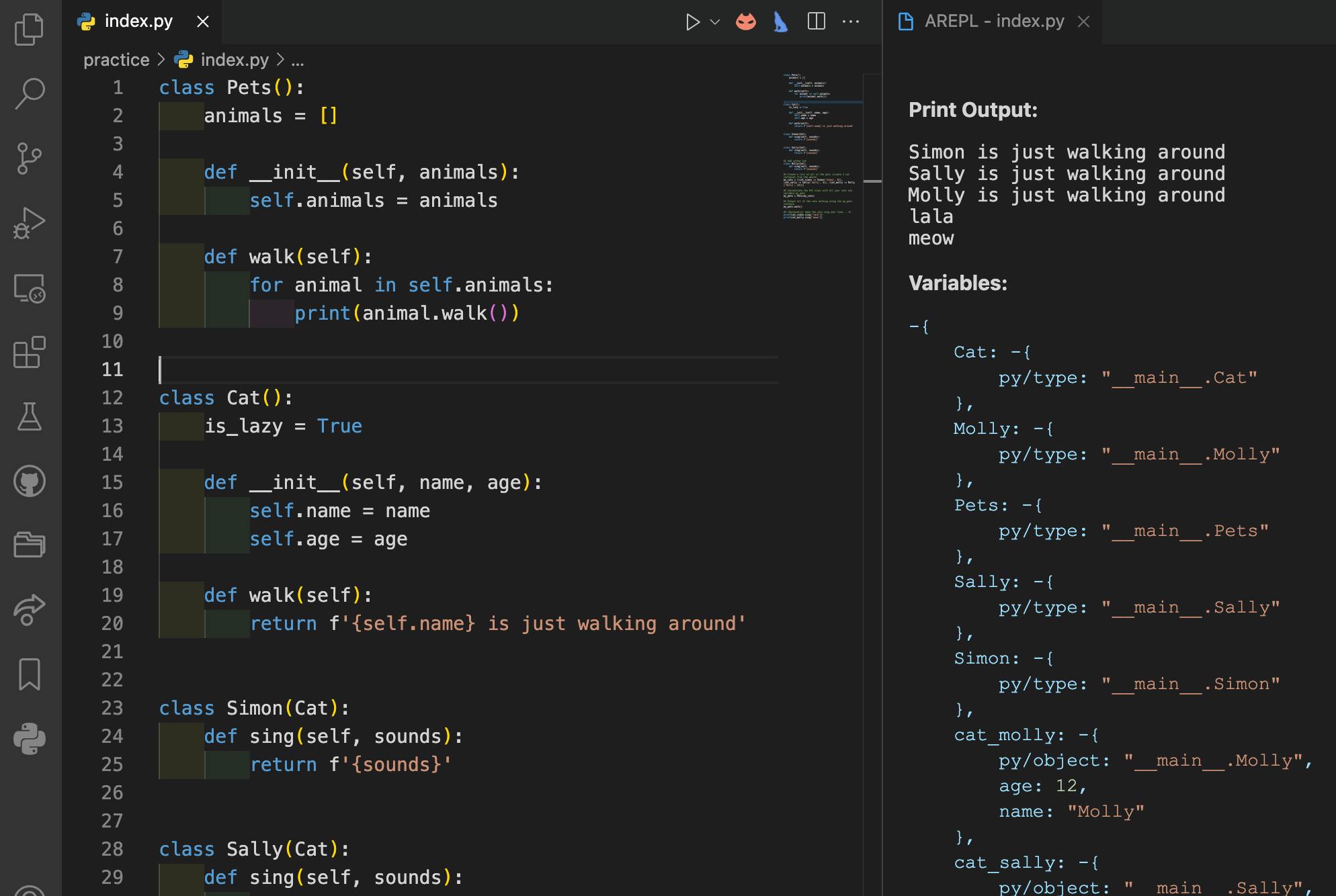
16. Use Parent Constructor Init function
>>Return to Menu
class Student():
def __init__(self,name,age,sex):
self.name = name
self.age = age
self.sex = sex
def details(self):
return {'name': self.name, 'age': self.age, 'sex': self.sex}
class Course(Student):
def __init__(self,name,age,sex,course,score,is_pass):
Student.__init__(self,name,age,sex)
self.course = course
self.score = score
self.is_pass = is_pass
def details(self):
return {'name': self.name,
'age': self.age,
'sex': self.sex,
'course': self.course,
'score': self.score,
'is_pass': self.is_pass,}
student1 = Course('Andrew',34,'Male','Maths',82,True)
print(student1.details())
print(Student.details(student1))
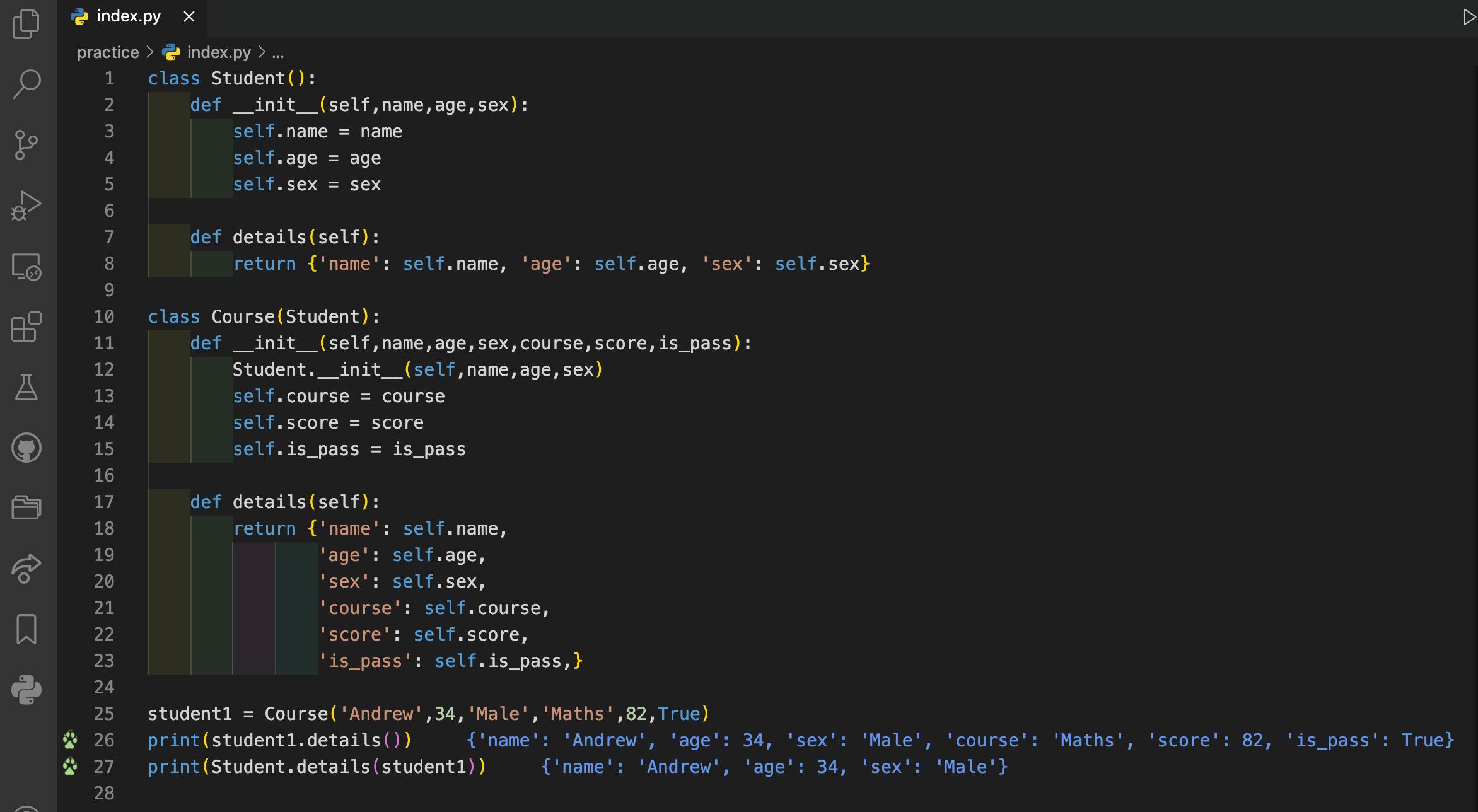
17. Use Parent Constructor Init with super()
>>Return to Menu
class Student():
def __init__(self,name,age,sex):
self.name = name
self.age = age
self.sex = sex
def details(self):
return {'name': self.name, 'age': self.age, 'sex': self.sex}
class Course(Student):
def __init__(self,name,age,sex,course,score,is_pass):
super().__init__(name,age,sex)
self.course = course
self.score = score
self.is_pass = is_pass
def details(self):
return {'name': self.name,
'age': self.age,
'sex': self.sex,
'course': self.course,
'score': self.score,
'is_pass': self.is_pass,}
student1 = Course('Andrew',34,'Male','Maths',82,True)
print(student1.details())
print(Student.details(student1))

18. Use dir() to view Attributes and Methods of Object
>>Return to Menu
class Student():
def __init__(self,name,age,sex):
self.name = name
self.age = age
self.sex = sex
def details(self):
return {'name': self.name, 'age': self.age, 'sex': self.sex}
class Course(Student):
def __init__(self,name,age,sex,course,score,is_pass):
super().__init__(name,age,sex)
self.course = course
self.score = score
self.is_pass = is_pass
def details(self):
return {'name': self.name,
'age': self.age,
'sex': self.sex,
'course': self.course,
'score': self.score,
'is_pass': self.is_pass,}
student1 = Course('Andrew',34,'Male','Maths',82,True)
print(dir(student1))

19. Dunder Methods
>>Return to Menu
class Toy():
def __init__(self, color, age):
self.color = color
self.age = age
self.my_dict = {
'name':'Yoyo',
'has_pets': False,
}
def __str__(self):
return f"{self.color}"
def __len__(self):
return 5
def __del__(self):
return "deleted"
def __call__(self):
return('yes??')
def __getitem__(self,i):
return self.my_dict[i]
Bob_the_builder = Toy('red', 2)
print(Bob_the_builder.__str__())
print(str(Bob_the_builder))
print(len(Bob_the_builder))
print(Bob_the_builder())
print(Bob_the_builder['name'])
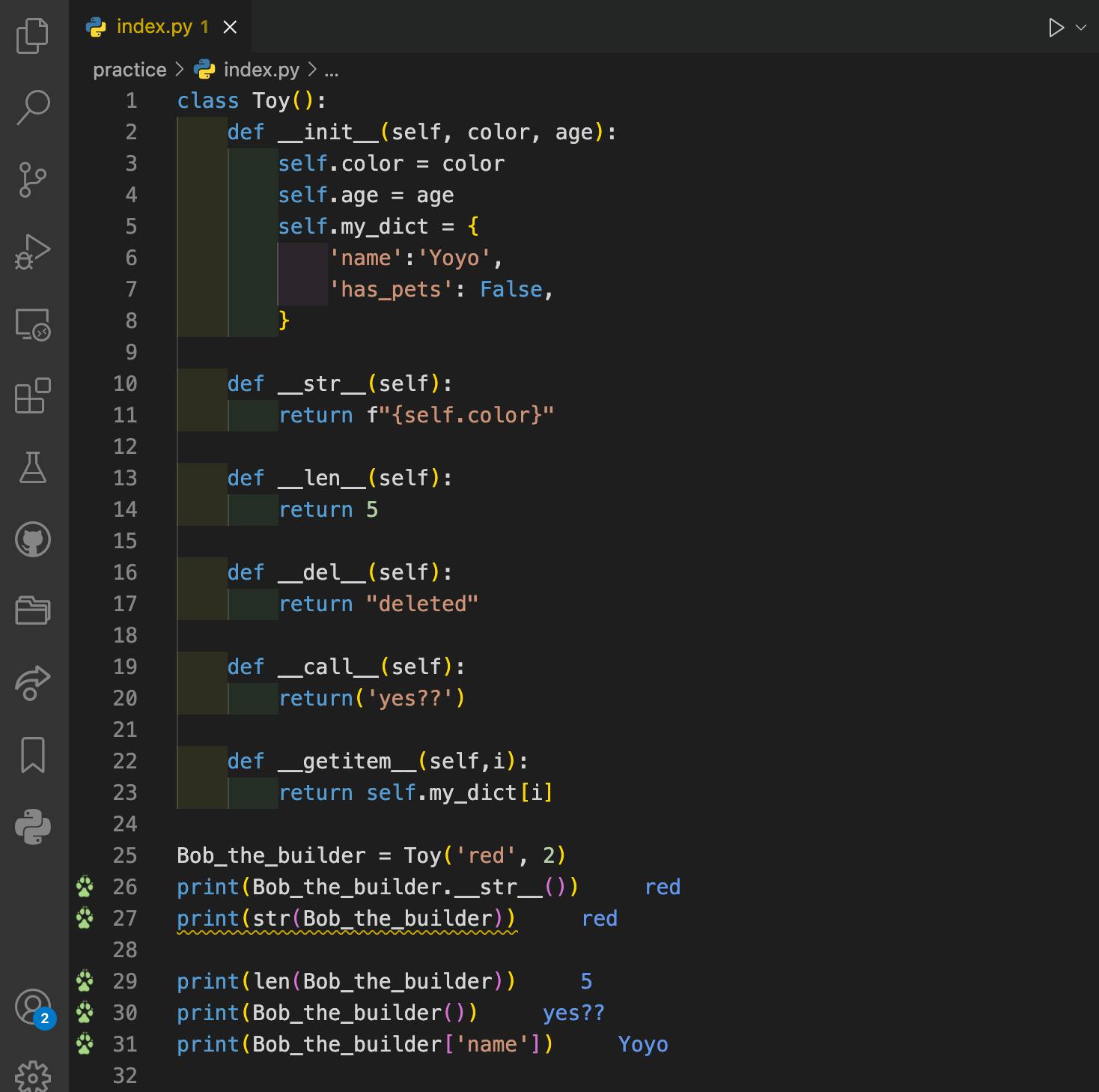
20. Dunder Methods - SuperList Example
>>Return to Menu
class SuperList(list):
def __len__(self):
return 1000
super_list1 = SuperList();
print(len(super_list1))
super_list1.append(5)
print(super_list1[0])

21. Issubclass Method
>>Return to Menu
class SuperList(list):
def __len__(self):
return 1000
super_list1 = SuperList();
print(len(super_list1))
super_list1.append(5)
print(super_list1[0])
print(issubclass(SuperList, list))
print(issubclass(list, object))
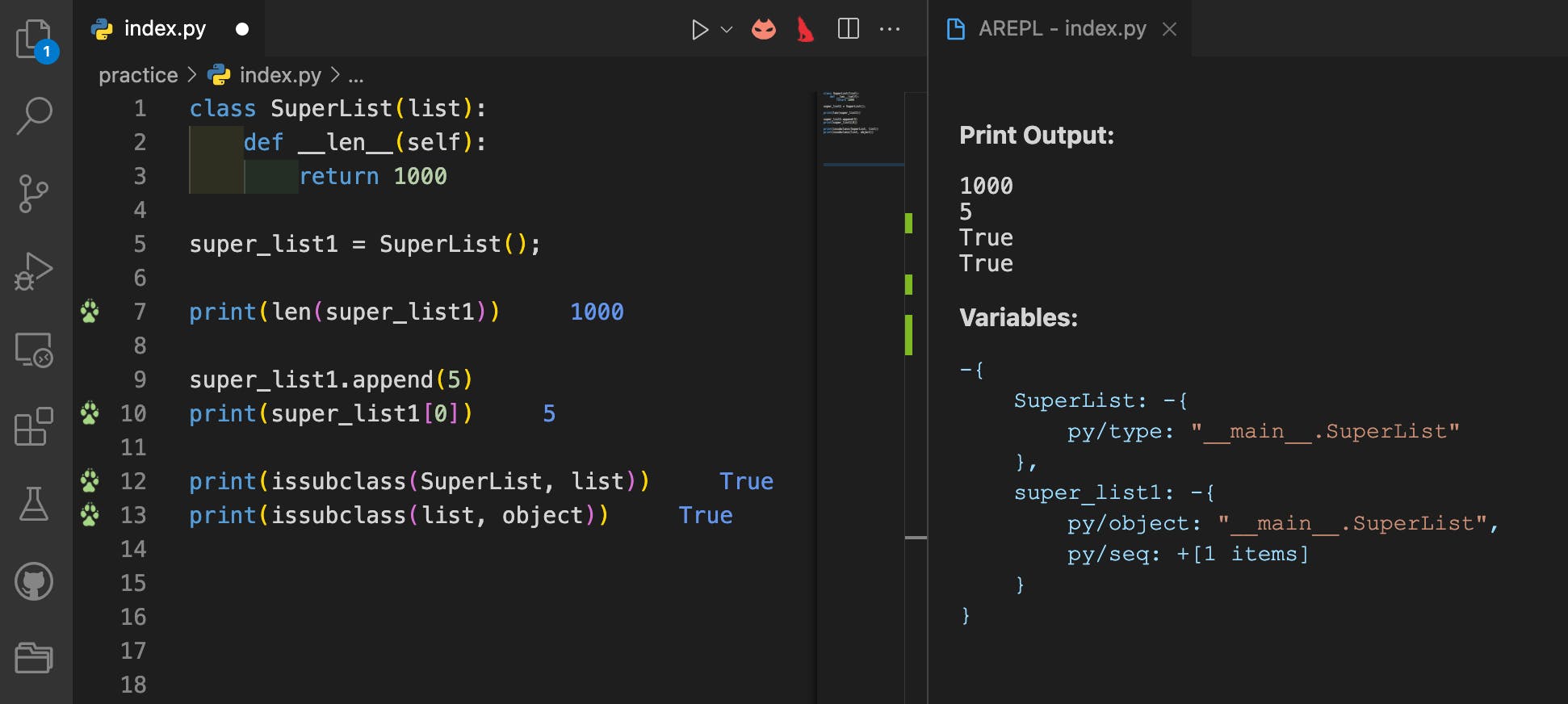
22. MRO - Method Resolution Order
>>Return to Menu
#MRO - Method Resolution Order
class A:
num = 10
class B(A):
pass
class C(A):
num = 1
class D(B, C):
pass
print(D.mro())
print(D.__mro__)
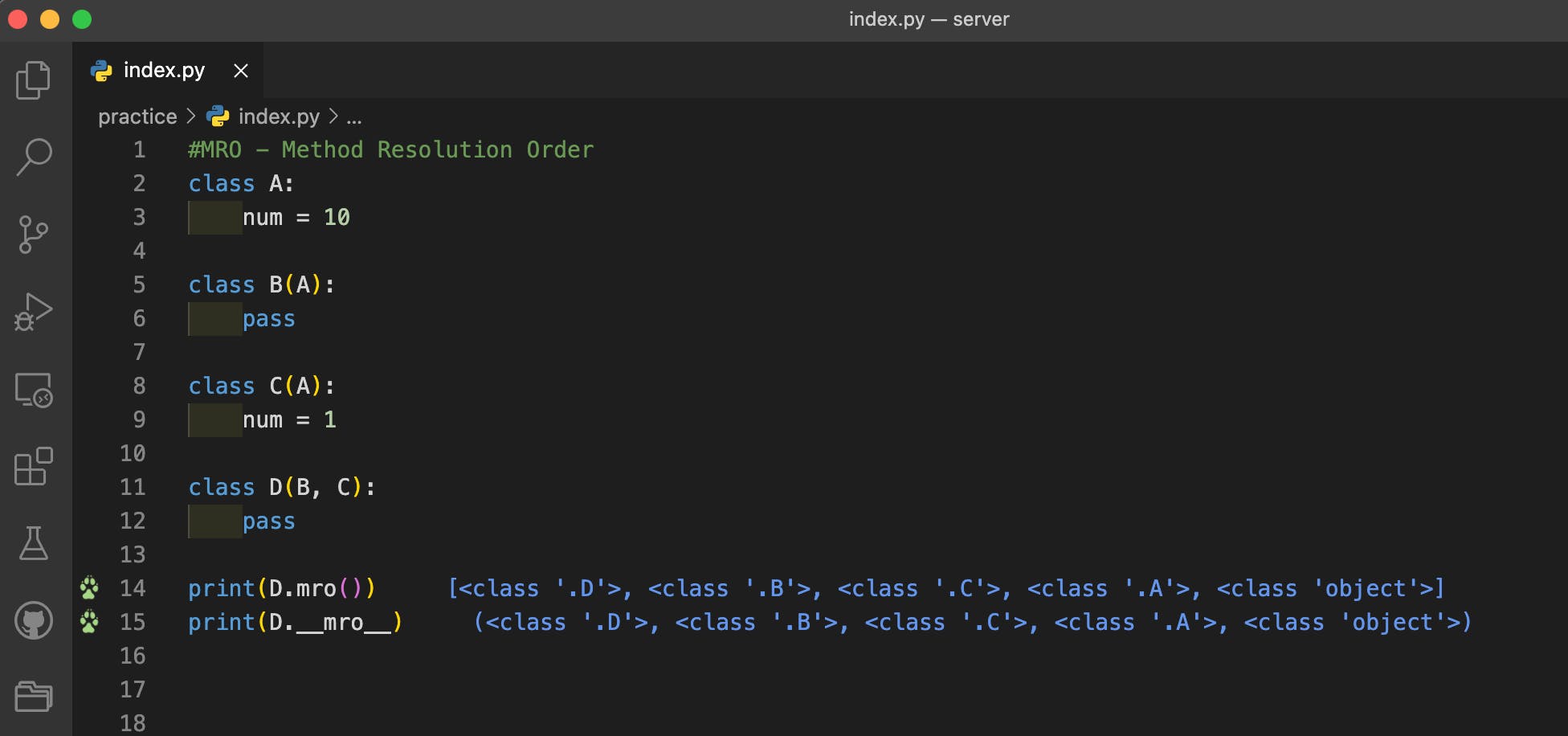
23. OOP Example I
>>Return to Menu
class Employee():
raise_amt = 1.04
def __init__(self, first, last, pay):
self.first = first
self.last = last
self.pay = pay
self.email = f'{first.lower()}.{last.lower()}@gmail.com'
def fullname(self):
return '{} {}'.format(self.first, self.last)
def apply_raise(self):
self.pay = int(self.pay * self.raise_amt)
class Developer(Employee):
raise_amt = 1.10
def __init__(self, first, last, pay, prog_lang):
super().__init__(first, last, pay)
self.prog_lang = prog_lang
class Manager(Employee):
def __init__(self, first, last, pay, employees=None):
super().__init__(first, last, pay)
self.employees = [] if employees is None else employees
def add_employee(self, employee):
if employee not in self.employees:
self.employees.append(employee)
def remove_employee(self, employee):
if employee in self.employees:
self.employees.remove(employee)
def print_employees(self):
for employee in self.employees:
print('--->', employee.fullname())
dev1 = Developer('Mike','Smith', 50000, 'Python')
dev2 = Developer('Mary','Poppings', 60000, 'Java')
manager1 = Manager('James','Thomas',90000)
manager1.add_employee(dev1)
manager1.add_employee(dev2)
manager1.print_employees()
print(manager1.fullname())
print(isinstance(manager1, Developer))
print(issubclass(Developer, Employee))
#End
Hope you enjoyed this! :) Follow me for more contents...
Get in Touch:
ifeanyiomeata.com
contact@ifeanyiomeata.com
Youtube: youtube.com/c/IfeanyiOmeata
Linkedin: linkedin.com/in/omeatai
Twitter: twitter.com/iomeata
Github: github.com/omeatai
Stackoverflow: stackoverflow.com/users/2689166/omeatai
Hashnode: hashnode.com/@omeatai
Medium: medium.com/@omeatai
© 2022

